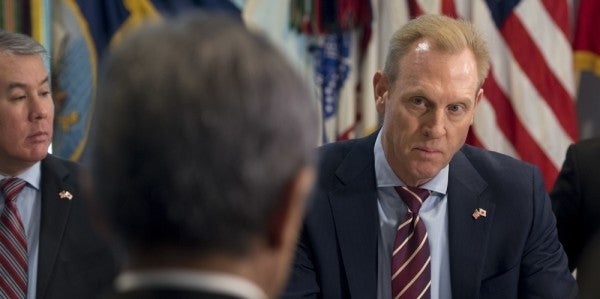This One Book Will Tell You Everything You Need To Know About Acting SecDef Patrick Shanahan
"His views are all in there: his leadership philosophy, his ideas on establishing harmony across large organizations, and the way he compartmentalizes a broad problem set into identifiable, solvable chunks."

You can learn about leaders from the books that inspire them. Former Defense Secretary James Mattis frequently turned to “Meditations” by Marcus Aurelius to put things into perspective – both in combat and in the vipers nest known as Washington, D.C.
Now the torch has been passed to Acting Defense Secretary Patrick Shanahan, who looks to more recent history for leadership lessons. One book he often recommends “Freedom's Forge,” about how American industry teamed up with the War Department during World War II to build more ships, planes, and tanks than Germany and Japan could possibly match.
“His views are all in there: his leadership philosophy, his ideas on establishing harmony across large organizations, and the way he compartmentalizes a broad problem set into identifiable, solvable chunks,” said his spokesman Army Lt. Col. Joe Buccino.
Mattis wanted the U.S. military to become more lethal. Shanahan wants the Pentagon to become more productive, effective, and streamlined.
“This is the 'Department of Get Stuff Done,'” Shanahan said during the Jan. 17 release of the Pentagon's Missile Defense Review.
“Freedom's Forge” by Arthur Herman shows what this country can accomplish when the American people are united by patriotism, Shanahan told Task & Purpose.
“Our history shows there is no problem we cannot solve together and 'Freedom's Forge' bears that out,” Shanahan said in a statement. “American capability is virtually boundless, particularly when unified purpose is established among all factions of our citizenry.”
An engineer by training, Shanahan admires captains of industry who have plowed through bureaucracy to overcome seemingly insurmountable obstacles. “Freedom's Forge” details how America's top businessmen of their day took drastic pay cuts to focus on the greater good.
They were more interested in getting results than promoting themselves and they achieved what no one thought possible.
Working together, American businesses turned the United States into the “arsenal of democracy,” building more than 324,000 aircraft, 141 aircraft carriers, 2.6 million machine guns, and 41 billion rounds of ammunition, Herman wrote.
“Most accounts of America in World War II center on the great climactic battles from Midway and Tarawa to D-Day and Iwo Jima,” Herman wrote. “The battles American business fought and won came earlier – some a year before the country went to war. Yet they enabled the United States to win those battles to come, and crush the forces of Fascism. In so doing, they transformed America's military into the biggest and most powerful in the world.”
One of the book's heroes is William S. Knudsen, who was president of General Motors when President Franklin Delano Roosevelt asked him to help with war production in May 1940. Knudsen, who eventually received a commission to Army lieutenant general, agreed to work for a salary of $1 per year.
That July, a British official told U.S. Treasury Secretary Henry Morgenthau Jr. that the British would need 4,000 planes per month from the United States by the end of 1941, Herman wrote. At the time, U.S. industry was only producing 500 aircraft per month.
“Pass the ball to Knudsen,” Morgenthau replied. “He's the kind of production man who will rise to a challenge like that and meet it.”
Although initially shocked, Herman wrote, Knudsen vowed to do all that he could to get the British the planes they needed.
Like Knudsen, Shanahan developed a reputation as a Boeing executive for being able to meet any challenge, including rescuing the 787 Dreamliner from almost certain failure.
Alan Mulally, former CEO of Ford Motor Company, said he was struck by Shanana's can-do attitude and his ability to get everyone on the same page when the two men worked at Boeing.
“He really believes in talented people working together – not only a smart organization but also a smart and a healthy organization, meaning everybody knows what the plan is; they know what the status is; and they're all committed to working together,” Mulally said.
Jeff Schogol covers the Pentagon for Task & Purpose. He has covered the military for 13 years and embedded with U.S. troops in Iraq and Haiti. Prior to joining T&P, he covered the Marine Corps and Air Force at Military Times. Comments or thoughts to share? Send them to Jeff Schogol via email at schogol@taskandpurpose.com or direct message @JeffSchogol on Twitter.
